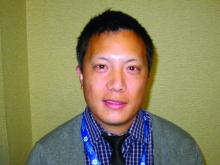WASHINGTON – Pressure on physicians to prescribe fewer opioids could have unintended consequences in the absence of adequate access to treatment, according to experts.
“There is mixed evidence that, when medication-assisted treatment is lacking, there are higher rates of transition from prescription opioids to heroin,” Gary Tsai, MD, said during a presentation at the American Psychiatric Association’s Institute on Psychiatric Services.
“As we constrict our prescribing, we want to make sure that there is ready access to these interventions, so that those who are already dependent on opioids can transition to something safer,” said Dr. Tsai, medical director and science officer of Substance Abuse Prevention and Control, a division of Los Angeles County’s public health department.
Medication-assisted treatment (MAT) uses methadone, buprenorphine, or naltrexone in combination with appropriate behavioral and other other psychosocial therapies to help achieve opioid abstinence. Despite MAT’s well-established superiority to either pharmacotherapy or psychosocial interventions alone, the use of MAT has, in some cases, declined. According to the Substance Abuse and Mental Health Services Administration (SAMHSA), MAT was used in 35% of heroin-related treatment admissions in 2002, compared with 28% in 2010.
Reasons for MAT’s difficult path to acceptance are manifold, ranging from lack of certified facilities to administer the medications to misunderstanding about how the medications work, Dr. Tsai said.
A law passed earlier this year and the issuance of a final federal rule that increases the legal patient load that certified MAT providers can treat annually were designed to expand access to MAT. These, however, are only partial solutions, according to Margaret Chaplin, MD, a psychiatrist and program director of Community Mental Health Affiliates in New Britain, Conn.
“Can you imagine if endocrinologists were the only doctors who were certified to prescribe insulin and that each of them was only limited to prescribing to 100 patients?” Dr. Chaplin said in an interview. The final rule brought the number from 100 to 275 patients per year that a certified addiction specialist can treat. This might expand access to care, but “it sends a message that either the people with [addiction] don’t deserve treatment or that they don’t have a legitimate illness,” said Dr. Chaplin, who also was a presenter at the meeting.
Viewing people with opioid addiction through a lens of moral failing only compounds the nation’s addiction crisis, Dr. Chaplin believes. “Not to say that a person with a substance use disorder doesn’t have a responsibility to take care of their illness, [but] our [leaders] haven’t been well educated on the scientific evidence that addiction is a brain disease.”
It is true that, until the Comprehensive Addiction and Recovery Act was signed into law over the summer, nurse practitioners and physician assistants could have prescribed controlled substances such as acetaminophen/oxycontin but not the far less dangerous – and potentially life-saving – partial opioid agonist buprenorphine. Under the new law, those health care professions now have the same buprenorphine prescribing rights as physicians.
New legislation does not guarantee access to treatment, however. “Funding for MAT programs varies throughout the states, and the availability of these medications on formularies often determines how readily accessible MAT interventions are,” said Dr. Tsai, who emphasized the role of collaboration in ensuring the laws take hold.
“Addiction specialists comprise a minority of the work force. To scale MAT up, we need to engage other prescribers from other systems, including those in primary care and mental health,” Dr. Tai said. To wit, the three primary MAT facilities in Los Angeles County offer learning collaboratives with primary care clinicians who want to incorporate these services into their practice, even if they are not certified addiction specialists themselves. This helps increase referrals to the treatment facilities, he explained.
Overcoming resistance to offering MAT ultimately will depend on educating leaders about the costs of not doing so, Dr. Tsai and Dr. Chaplin said.
“Our system has been slow to adopt a disease model of addiction,” Dr. Chaplin said. “Buprenorphine and methadone are life-saving medical treatments that are regulated in ways that you don’t see for any other medical condition.”
SAMHSA currently is requesting comments through Nov. 1, 2016, on what should be required of MAT providers under the new law.
Neither Dr. Tsai nor Dr. Chaplin had any relevant disclosures.
On Twitter @whitneymcknight

